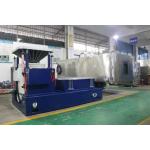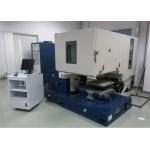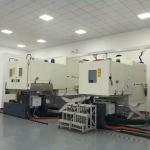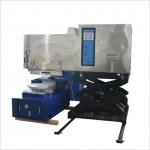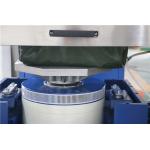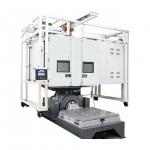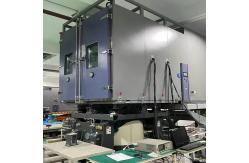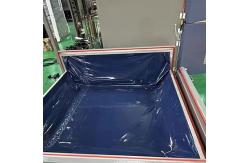In the packaging industry, the performance and durability of
corrugated containers are of utmost importance. To ensure that
these containers can withstand the rigors of transportation and
storage, accurate and comprehensive testing is essential. The
customized environmental chamber with a vibration table is a
cutting-edge solution designed specifically for laboratory testing
of corrugated containers. This advanced testing apparatus is dedicated to simulating the
various environmental and mechanical stresses that corrugated
containers may experience during their lifecycle. It serves the
packaging manufacturing industry, shipping companies, and quality
control laboratories. The primary objective is to evaluate the
integrity and strength of corrugated containers under different
temperature, humidity, and vibration conditions. By conducting
these tests, manufacturers can optimize their container designs,
select appropriate materials, and ensure compliance with industry
standards and regulations. - Robust and Insulated Chamber Construction
- The environmental chamber is built with a heavy-duty steel frame
that provides exceptional rigidity and stability. The frame is
coated with a corrosion-resistant finish to enhance its durability.
The chamber walls are made of high-quality insulation materials,
which minimize heat transfer and maintain precise temperature and
humidity levels. The insulation is carefully engineered to
withstand the rigors of continuous testing and prevent any external
factors from interfering with the internal test environment. The
chamber is also equipped with a hermetic door seal, ensuring a
leak-free enclosure and consistent test conditions.
- Precision Temperature and Humidity Control System
- The chamber features a highly accurate temperature and humidity
control system. It can maintain a wide temperature range, from
-20°C to +80°C, with an accuracy of ±0.5°C. The humidity control
range extends from 10% to 95% relative humidity, with an accuracy
of ±3% RH. The system utilizes advanced refrigeration units,
electric heaters, humidifiers, and dehumidifiers to achieve and
maintain the desired environmental conditions. Temperature and
humidity sensors are strategically placed within the chamber to
provide real-time feedback, enabling the control system to make
rapid and precise adjustments.
- High-Performance Vibration Table
- The vibration table incorporated into the system is engineered for
precision and power. It can generate a wide range of vibration
frequencies, typically from 5 Hz to 2000 Hz, covering the spectrum
of vibrations encountered during transportation. The amplitude of
vibration can be precisely controlled, ranging from a few
micrometers to several centimeters. The table is equipped with a
high-torque motor and advanced servo control system, ensuring
accurate and repeatable vibration patterns. It also features a
rigid surface and excellent dynamic balance, minimizing any
unwanted resonances or vibrations that could affect the test
results.
- Synchronized Control and Data Acquisition
- The system is equipped with a sophisticated control panel that
allows for seamless synchronization of vibration and environmental
parameters. Operators can precisely program the sequence and
intensity of vibrations, temperature changes, and humidity levels,
creating custom test profiles. The control panel also provides
real-time monitoring of all test parameters, including temperature,
humidity, vibration frequency, amplitude, and container status. The
data acquisition system records detailed information about the
test, such as temperature and humidity profiles, vibration
waveforms, and any changes in the physical properties of the
corrugated container. The acquired data can be stored in a variety
of formats and analyzed using specialized software to generate
comprehensive test reports.
- Customizable Interior and Fixtures
- The chamber offers a customizable interior space to accommodate
different sizes and shapes of corrugated containers. It can be
equipped with adjustable racks, shelves, and mounting fixtures,
allowing for flexible test setups. The interior surfaces are made
of non-corrosive and non-reactive materials to prevent any
contamination or interaction with the containers. Additionally, the
chamber can be fitted with various accessories, such as cable ports
for sensor connections, viewing windows for visual inspection, and
access doors for easy container loading and unloading.
- Maximum Vibration Displacement
- The vibration table can achieve a maximum displacement of ±50 mm.
This significant displacement capacity allows for the simulation of
severe vibration conditions, such as those experienced during rough
transportation on bumpy roads or in vibrating trucks. For example,
in testing the durability of corrugated containers used for
shipping heavy machinery parts, a large vibration displacement can
help uncover potential weaknesses in the container design or
material under extreme mechanical stress.
- Vibration Frequency Range
- As mentioned, the frequency range of 5 Hz to 2000 Hz covers a wide
spectrum of vibrations. Low-frequency vibrations can affect the
stability and alignment of larger containers, while high-frequency
vibrations can cause fatigue and failure in the corrugated board
and its joints. Testing across this frequency range ensures a
comprehensive evaluation of a container's performance under
different vibration scenarios.
- Thermal Shock Temperature Range
- The ability to transition from -20°C to +80°C provides a broad
range of thermal shock conditions. This is crucial for assessing
how corrugated containers respond to sudden temperature changes,
such as when moving from a cold storage facility to a hot
transportation vehicle or vice versa. In the food and
pharmaceutical industries, where products may be stored and shipped
under different temperature conditions, this testing helps ensure
the integrity of the packaging and the safety of the contents.
- Temperature Transition Rate
- The chamber can achieve a temperature transition rate of up to 3°C
per minute. This rapid rate of temperature change is essential for
accurately simulating real-world thermal shock events. For
instance, in testing the integrity of a corrugated container used
for shipping electronic components, a fast temperature transition
can reveal any cracks or weaknesses that may develop due to thermal
stress.
- Maximum Payload Capacity
|
